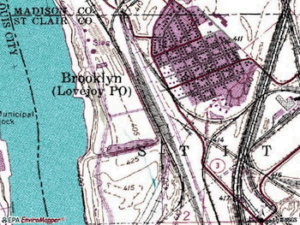
*Brooklyn, Illinois, was incorporated on this date in 1873. It is one of the oldest towns incorporated by African Americans in the United States.
The State name "Illinois" comes from a Native American word meaning "tribe of superior men." Illinois became a state on December 3, 1818. The town of Brooklyn, also known as Lovejoy, is located two miles north of East St. Louis, Illinois, and three miles northeast of downtown St. Louis, Missouri. It is located in St. Clair County, Illinois. Its motto is "Founded by Chance, Sustained by Courage." The mayor is Mayor Vera Banks-Glasper as of 2018.
According to oral history tradition, in 1829, "Mother" Priscilla Baltimore led a group of eleven fugitive and free black families to flee slavery in St. Louis, Missouri. They crossed the Mississippi River to the free state of Illinois, where they established a freedom village in the American Bottoms. This area is the Mississippi River flood plain in the Metro-East region of Southern Illinois, extending from Alton, Illinois, south to the Kaskaskia River. "Mother" Baltimore purchased her freedom as an adult from her master. She also bought the freedom of members of her family. Born in Kentucky, she tracked her white father to Missouri and bought her mother's freedom from him.
The earliest Black family names included Anderson, Sullivan, Singleton, Wilson, Cox, Wyatt, and Carper. Baltimore had become a Methodist preacher and participated in the religious life of the new settlement. William Paul Quinn, then a missionary of the newly formed African Methodist Episcopal Church (AME), visited the settlement in 1836 and helped found the Brooklyn AME church that year. He had been assigned as a missionary that year to what was then called the Northwest, including Indiana and Ohio. Quinn was also actively planting new congregations in Kentucky and Missouri; he later became the fourth bishop of the AME Church.
A missionary AME Church was established there in 1836. The AME Church was founded as a denomination by free blacks in Philadelphia and its region in 1816. Now known as Quinn's Chapel AME, its congregation supported the Underground Railroad and aided fugitive slaves to freedom, together with members of the Antioch Baptist Church established in 1838. Quinn Chapel was the first of those newly formed, independent Black denominations to be built west of the Appalachian Mountains, and the first was built in Illinois.
Miranda Yancey-Bailey, an archeologist, has found written evidence that Baltimore still lived in St. Louis in the 1830s; the first documentation of her association with Brooklyn is from 1839. She may have been traveling between these locations. 1837 five white abolitionists platted the land and created an unincorporated Black town. Thomas Osburn was one of them, documented as having lived in the area for decades. Priscilla Baltimore built a house on his former land, which she occupied from 1851-1872. In the 1840s and 1850s, the African American population of the village was about 200.
Before the American Civil War and Emancipation, residents here may have used Quinn Chapel AME Church and Antioch Baptist Church (1838) as stations on the Underground Railroad to aid slaves in escaping to freedom. Both of these church buildings have survived. Antioch Baptist Church also still stands. After Brooklyn, Illinois, was incorporated, its population included 371 African American and 203 European American residents in 1880. In the late 19th century, its residents took new jobs, commuting to those in East St. Louis and nearby areas that would build race autonomy and self-determinism.
In 1886, the African American majority worked to register voters and gained political control of the village. As with most political enterprises, factions developed within the community. Regional capital investment largely bypassed Brooklyn in the competing East St. Louis, Illinois, which gained the all-important railroad connection. Other white-majority towns also benefited from being part of the investment network. Almost none of the all-Black towns obtained a railroad." The small village soon became all Black.
In 1891, the town's new post office was named Lovejoy (after the abolitionist Elijah P. Lovejoy, who had been assassinated in Alton, Illinois, in 1837); their high school was named after him. Black autonomy did not automatically yield unity in the village. Tensions were high with class and color conflicts and evidence of political corruption by the 1900s. In addition, with the growth in the number of young, single male workers attracted to industrial jobs, the demographics changed, and family life in the village declined. With the decline of an industry from the mid-20th century and the loss of jobs, Brooklyn has suffered high unemployment and problems similar to those of East St. Louis.
It has struggled with crime and a limited economy and tax base. A bar and strip club cluster provides a revenue source in its limited economy. Tina Turner regularly performed as an entertainer at a local club in her early years. In 2007, three-quarters of Brooklyn's revenue of $380,000 came through sales tax and a $30,000 licensing fee from the adult clubs. A state archeological survey was required before constructing the Stan Musial Veterans Memorial Bridge between St. Louis and Illinois, which would require the realignment of part of Rte. Three near the village.
In 2002, work revealed extensive prehistoric artifacts. This site lies within Brooklyn's incorporated limits but just east of the historical residential part of town. It lies along the southern margin of the Horseshoe Lake meander just north of the East St. Louis Mound Group of earthworks. By the end of the 2007 field season, the team had excavated 7,000 prehistoric features, making this one of the largest American sites ever excavated. Most of these features are associated with the Late Woodland Patrick phase and early Terminal Late Woodland Lloyd phase, from 600 AD to 1200 AD. They suggest a more complex and dense indigenous native American community than researchers had known lived in the area.
The Illinois State Archaeological Survey (ISAS) and the University of Illinois conducted outreach with the village of Brooklyn, volunteering to survey some areas associated with its early 19th-century history. A team of archaeologists found evidence of early African American occupation from 1830 to 1850 and material in other areas from 1850 to 1870. This discovery suggests that the remains of Mother Baltimore's Freedom Village survive beneath the surface in Upper Brooklyn. It also means that artifacts and other evidence of the town's founding may be revealed if future excavations are conducted there. This would enhance the town's historical significance and research potential.
Since the turn of the 21st century, residents have rallied around new work related to documenting the village's rich historical past. They’ve collected oral histories and personal accounts of the town. In 2007, residents founded the Historical Society of Brooklyn, Illinois. The historical society, with ISAS, the University of Illinois, and the Illinois State Museum, is working to preserve the history of Brooklyn. ISAS also helped the historical society to review documents to locate "Mother" Priscilla Baltimore's unmarked grave at Bellefontaine Cemetery in St. Louis. In 2010, the Brooklyn Historical Society installed a gravestone in her honor at the cemetery. In addition, ISAS will assist the village in surveying the Brooklyn cemetery to detect gravesites and try to document the history. Surveys in 2008 revealed that "the archaeological record of Brooklyn lies intact beneath the extensive open spaces of current-day residential parcels."
In the summer of 2009, an archaeological field study began to excavate Mother Priscilla Baltimore's freedom village. The results of this collaborative project are expected to yield material that will aid the town in gaining designation for a historic district to be listed on the National Register of Historic Places. The Historical Society of Brooklyn and its collaborators are seeking national designation for three particularly significant sites: the late prehistoric Janey B. Goode archaeological site, identified as 11S1232; Brooklyn's historic cemetery, identified as 11S1233; and Quinn Chapel A.M.E. Church—built-in 1836. In 2015, St. Clair County's state attorney, Brendan Kelly, described the village as a 'failed state.
